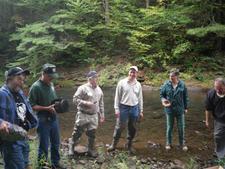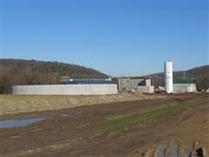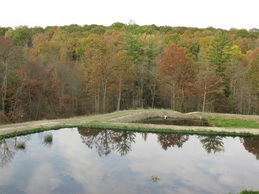Restoration Successes

While AMD may seem to large to tackle, many groups are taking on the challenge and restoring streams. It is this great work that is resulting in increased fish life in within the river, and miles of smaller streams supporting fish including trout. As funding and public support for AMD projects becomes less, touting these successes becomes more important. It is important for us all to celebrate the restoration of streams, and share our successes with those around us. Together we can restore the West Branch of the Susquehanna River, stream by stream.
Some examples of streams that have been improved in the West Branch are shown below. This information was adapted by the 2014 report "A Decade of Progress for the West Branch Susquehanna Restoration Initiative". The full report can be downloaded here.
Babb Creek- Babb Creek is a major tributary to Pine Creek. This story started in 1989 with the establishment of the Babb Creek Trust Fund. This fund, as well as grants and volunteer efforts, provided funding for more than a dozen AMD treatment Systems and reclamation projects. This work was celebrated in 2009, when members of the Babb Creek Watershed Association were able to declare that 14 miles of Babb Creek were now alive and thriving. The stream not only was removed from the impaired waters list, but it also was designated a wild trout fishery!
Bear Run- In 2008, Bear Run was an orange stream that supported very little life. The Susquehanna River Basin Commission (SRBC) and Indiana County Conservation District wanted to change that. So they applied for funding though the DEP to improve Bear Run. In an eight phase project the two organizations worked together to improve Bear Run through treatment and land reclamation. In 2012, 129 fish were caught in the stream including wild brook and brown trout.
Some examples of streams that have been improved in the West Branch are shown below. This information was adapted by the 2014 report "A Decade of Progress for the West Branch Susquehanna Restoration Initiative". The full report can be downloaded here.
Babb Creek- Babb Creek is a major tributary to Pine Creek. This story started in 1989 with the establishment of the Babb Creek Trust Fund. This fund, as well as grants and volunteer efforts, provided funding for more than a dozen AMD treatment Systems and reclamation projects. This work was celebrated in 2009, when members of the Babb Creek Watershed Association were able to declare that 14 miles of Babb Creek were now alive and thriving. The stream not only was removed from the impaired waters list, but it also was designated a wild trout fishery!
Bear Run- In 2008, Bear Run was an orange stream that supported very little life. The Susquehanna River Basin Commission (SRBC) and Indiana County Conservation District wanted to change that. So they applied for funding though the DEP to improve Bear Run. In an eight phase project the two organizations worked together to improve Bear Run through treatment and land reclamation. In 2012, 129 fish were caught in the stream including wild brook and brown trout.

Bennett Branch Sinnemahoning Creek- The work completed in the Bennett Branch is the result of partnerships. In 2004, the Department of Environmental Protection (DEP) began working with the Bennett Branch Watershed Association, other state and federal agencies, and the mining industry to improve this stream. Since that time treatment systems, and land reclamation have occurred that have restored 33 miles of the Bennett Branch and its tributaries. Some of these tributaries have not contained fish for roughly 100 years.
Clearfield Creek- Clearfield Creek contains about 500 miles of streams impaired by AMD, that's nearly half of all of the impaired streams in the West Branch. These numbers don't deter the Clearfield Creek Watershed Association (CCWA). CCWA and its many partners have worked to improve the stream and will soon see Little Laurel Run restored. Other work in the watershed includes work by the Clearfield County Conservation District to improve Morgan Run. The work is slow, and the problem large but Clearfield Creek is slowly improving!
Clearfield Creek- Clearfield Creek contains about 500 miles of streams impaired by AMD, that's nearly half of all of the impaired streams in the West Branch. These numbers don't deter the Clearfield Creek Watershed Association (CCWA). CCWA and its many partners have worked to improve the stream and will soon see Little Laurel Run restored. Other work in the watershed includes work by the Clearfield County Conservation District to improve Morgan Run. The work is slow, and the problem large but Clearfield Creek is slowly improving!

Kettle Creek- The majority of Kettle Creek watershed contains some of Pennsylvania's best trout streams. The very lower section is impaired by AMD. Trout Unlimited partnered with the Kettle Creek Watershed Association, and many other partners to remedy this problem. Together they have completed land reclamation and nine treatment systems in the watershed. With the completion of a large land reclamation project scheduled to be finished in 2015 it is hoped that 11 miles of trout stream will be restored and connected to Kettle Creek itself. Already benefits are being seen, and trout can now be found swimming in streams they could not survive in for over 100 years.
Tangascootack Creek- Lovingly called Scootak, this stream contributes AMD directly to the West Branch of the Susquehanna River. The Clinton County Conservation District and their partners have completed land reclamation and 6 treatment systems on the stream. These efforts were only completed in 2013, but already fish and other aquatic life are taking advantage of the newly improved stream. It is hoped that soon this stream will be removed from the list of impaired streams in PA.
Tangascootack Creek- Lovingly called Scootak, this stream contributes AMD directly to the West Branch of the Susquehanna River. The Clinton County Conservation District and their partners have completed land reclamation and 6 treatment systems on the stream. These efforts were only completed in 2013, but already fish and other aquatic life are taking advantage of the newly improved stream. It is hoped that soon this stream will be removed from the list of impaired streams in PA.
